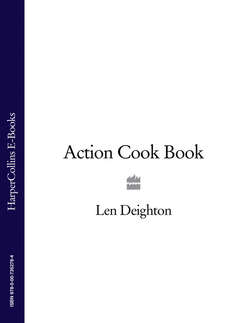Читать книгу Action Cook Book - Len Deighton - Страница 11
THE AUTOMATIC COOKER AND THE PRESSURE COOKER
ОглавлениеThese are both luxury utensils, but they will bring not just a saving in time but a gain in precision to your cooking. These two devices, plus a gas ring, can give you an infinite variety of cookery. With them you can steam, boil, stew, poach, braise, fry, roast and even bake. In this short note I only tell you what I use them for, but you may find all sorts of additional advantages. They will be of equal use to the gas-ring gourmet and to the cook with a vast stainless-steel kitchen.
The device which the Sunbeam company call their Automatic Cooker is often described as an electric frying pan. I prefer to call it a thermostat-controlled casserole. While gas rings are unbeatable for quick adjustment of heat, electric thermostats and simmerstats can be adjusted to keep the heat just right under a stew or braise. On page 32 you will see the burning points of various fats. Cooking in butter? Set the control to just below 278° without risk of disaster. Similarly use the boiling point of water to poach a fish gently so that the convection doesn’t smash it into flakes. Heat milk, but never boil it over by setting below its boiling point.
Escoffier once wrote, ‘Of all the various culinary operations, braisings are the most expensive and the most difficult.’ To braise a good-quality piece of meat, set it upon a bed of lightly fried vegetables in which onion predominates. Put the lid on the cooker and set the control to a fraction above the boiling point of water, then the moisture that comes out of the meat turns to steam and leaves a glazed layer over the meat. The cook must spoon just a little moisture over the meat as often as possible (say every 15 minutes), using good stock. This will result in a real braise and is much better than swamping the meat with liquid and letting it diminish by evaporation. Many vegetables (e.g. celery, leek, turnip, etc.) are suitable for braising.
Use this same basic idea but add more liquid to produce stews and casseroles that cook at exact gentle heat.
The Pressure Cooker will not only cut cooking times to about one-third, but will also cook certain foods particularly well. Read your instruction book, remembering that only when you hear hissing is the food cooking. Time from that moment on.
For things that spoil if overcooked, deliberately undercook, then finish them off by using the cooker as though it were an ordinary saucepan. In this way you can keep an eye on the contents towards the end of the cooking time. Don’t wander out of earshot during pressure-cooking time. If the cooker goes silent, it is either because the heat isn’t high enough or because it has burnt dry. Either way it needs attention. When cooking time is up, reduce pressure by cooling. Either put the cooker under running cold water, or stand it aside and let it cool gently. The former method is quick, but will throw the food inside about violently. Choose accordingly. Always before beginning check escape vent and washer (a dirty washer will let pressure escape).
The pressure cooker is at its best when neither overcooking nor violent movement of air will affect the result, e.g. for steak pudding, tomato soup, stock, soups of all kinds, stews, removing marrow from bones, cooking salt beef (brisket needs about 25 minutes to the pound), steamed puddings (rolypoly, etc.). Other highly successful pressure-cooker uses: cooking dried fruits, steamed egg custard (cover it well). The most successful vegetables to pressure-cook are the ones that will end up mashed, e.g. potatoes, swedes, turnips. Green vegetables are so quick to cook that it is not worth pressure-cooking them.
